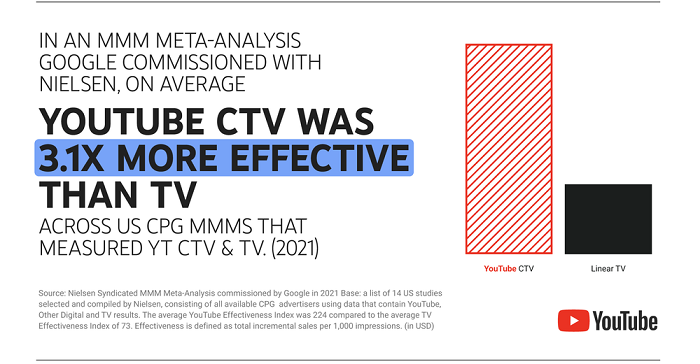SOCIAL
YouTube Adds New CTV Campaign Measurement Verification Through Expanded Nielsen Partnership

With connected TV (CTV) watch time on the rise (aka people watching digital video content on their home TV sets), YouTube’s looking to improve its CTV solutions for advertisers, in order to provide TV-like ad reach and resonance at a much more affordable price.
Which could be a key consideration for boosting brand awareness – but in order to ensure that advertisers get the most bang for their buck, YouTube also needs to be transparent in how it tracks the performance of its CTV options.
Which is where this new announcement comes in. Today, YouTube has announced an expansion of its partnership with Nielsen which will provide more ways for advertisers to measure their total audience reached by YouTube CTV campaigns.
As explained by YouTube:
“Last year, we launched Nielsen Digital Ad Ratings (DAR) and Comscore Campaign Ratings (CCR) to help you more easily measure your YouTube CTV campaigns alongside other media. Later this year, YouTube CTV and YouTube TV will be available in Nielsen Total Ad Ratings (TAR) in the US. This release will include deduplication of YouTube inventory across all platforms – CTV, computer, mobile and linear TV – to better compare YouTube reach to linear TV.”
In other words, YouTube will now provide more direct comparisons between your ad reach via traditional TV campaigns and YouTube CTV, independently verified by Nielsen’s measurement process.
“You’ll also see CTV device metrics within your media mix model (MMM) data feed, which can help measure sales outcomes and share insights on the impact of your YouTube CTV investment. To make the data analysis process faster for clients and easier for our measurement partners, we’ve launched a new data platform for MMM providers and advertisers to request data, track the status of those requests and ingest data directly.”
And again, it is definitely worth considering – according to Nielsen analysis, on average, YouTube CTV is 3.1x more effective than traditional TV across US consumer packaged goods (CPG) MMMs.
Expect those stats to keep leaning in YouTube’s favour over time, as more people watch even more YouTube content on their TV sets – which is especially relevant when you consider the media consumption habits of younger audiences, to whom YouTube has always been a primary entertainment option.
Last year, YouTube reported that over 120 million people are now consuming YouTube CTV content monthly, a number that’s projected to continue to rise in the coming years.

In addition to this, the actual reach of YouTube CTV should also factor in more viewers, with further Nielsen insights showing that 26% of the time, multiple 18+ viewers are watching YouTube together on the TV screen.
With this in mind, Google will also include co-viewing metrics in Nielsen’s DAR guarantees ad reporting for US Advertisers by the end of Q2, while it’s also adding new frequency controls for CTV campaigns to help avoid exposure fatigue.
It should be a key consideration for almost all brands, with TV campaigns traditionally driving the best response for brand awareness and action, and YouTube’s advanced targeting making them potentially even more effective, and cheaper, given the more specific audience focus options.
Of course, people can also just skip on through these ads, and for many, that’s almost a habitual response (my kids just exit the video and re-load to avoid the pre-rolls). But even so, there is big potential here, and the right targeting and products could end up generating big results from YouTube’s advancing CTV offerings.
You can learn more about YouTube’s latest CTV ad updates here.
Source link
SOCIAL
Snapchat Explores New Messaging Retention Feature: A Game-Changer or Risky Move?

In a recent announcement, Snapchat revealed a groundbreaking update that challenges its traditional design ethos. The platform is experimenting with an option that allows users to defy the 24-hour auto-delete rule, a feature synonymous with Snapchat’s ephemeral messaging model.
The proposed change aims to introduce a “Never delete” option in messaging retention settings, aligning Snapchat more closely with conventional messaging apps. While this move may blur Snapchat’s distinctive selling point, Snap appears convinced of its necessity.
According to Snap, the decision stems from user feedback and a commitment to innovation based on user needs. The company aims to provide greater flexibility and control over conversations, catering to the preferences of its community.
Currently undergoing trials in select markets, the new feature empowers users to adjust retention settings on a conversation-by-conversation basis. Flexibility remains paramount, with participants able to modify settings within chats and receive in-chat notifications to ensure transparency.
Snapchat underscores that the default auto-delete feature will persist, reinforcing its design philosophy centered on ephemerality. However, with the app gaining traction as a primary messaging platform, the option offers users a means to preserve longer chat histories.
The update marks a pivotal moment for Snapchat, renowned for its disappearing message premise, especially popular among younger demographics. Retaining this focus has been pivotal to Snapchat’s identity, but the shift suggests a broader strategy aimed at diversifying its user base.
This strategy may appeal particularly to older demographics, potentially extending Snapchat’s relevance as users age. By emulating features of conventional messaging platforms, Snapchat seeks to enhance its appeal and broaden its reach.
Yet, the introduction of message retention poses questions about Snapchat’s uniqueness. While addressing user demands, the risk of diluting Snapchat’s distinctiveness looms large.
As Snapchat ventures into uncharted territory, the outcome of this experiment remains uncertain. Will message retention propel Snapchat to new heights, or will it compromise the platform’s uniqueness?
Only time will tell.
SOCIAL
Catering to specific audience boosts your business, says accountant turned coach

While it is tempting to try to appeal to a broad audience, the founder of alcohol-free coaching service Just the Tonic, Sandra Parker, believes the best thing you can do for your business is focus on your niche. Here’s how she did just that.
When running a business, reaching out to as many clients as possible can be tempting. But it also risks making your marketing “too generic,” warns Sandra Parker, the founder of Just The Tonic Coaching.
“From the very start of my business, I knew exactly who I could help and who I couldn’t,” Parker told My Biggest Lessons.
Parker struggled with alcohol dependence as a young professional. Today, her business targets high-achieving individuals who face challenges similar to those she had early in her career.
“I understand their frustrations, I understand their fears, and I understand their coping mechanisms and the stories they’re telling themselves,” Parker said. “Because of that, I’m able to market very effectively, to speak in a language that they understand, and am able to reach them.”Â
“I believe that it’s really important that you know exactly who your customer or your client is, and you target them, and you resist the temptation to make your marketing too generic to try and reach everyone,” she explained.
“If you speak specifically to your target clients, you will reach them, and I believe that’s the way that you’re going to be more successful.
Watch the video for more of Sandra Parker’s biggest lessons.
SOCIAL
Instagram Tests Live-Stream Games to Enhance Engagement

Instagram’s testing out some new options to help spice up your live-streams in the app, with some live broadcasters now able to select a game that they can play with viewers in-stream.
As you can see in these example screens, posted by Ahmed Ghanem, some creators now have the option to play either “This or That”, a question and answer prompt that you can share with your viewers, or “Trivia”, to generate more engagement within your IG live-streams.
That could be a simple way to spark more conversation and interaction, which could then lead into further engagement opportunities from your live audience.
Meta’s been exploring more ways to make live-streaming a bigger consideration for IG creators, with a view to live-streams potentially catching on with more users.
That includes the gradual expansion of its “Stars” live-stream donation program, giving more creators in more regions a means to accept donations from live-stream viewers, while back in December, Instagram also added some new options to make it easier to go live using third-party tools via desktop PCs.
Live streaming has been a major shift in China, where shopping live-streams, in particular, have led to massive opportunities for streaming platforms. They haven’t caught on in the same way in Western regions, but as TikTok and YouTube look to push live-stream adoption, there is still a chance that they will become a much bigger element in future.
Which is why IG is also trying to stay in touch, and add more ways for its creators to engage via streams. Live-stream games is another element within this, which could make this a better community-building, and potentially sales-driving option.
We’ve asked Instagram for more information on this test, and we’ll update this post if/when we hear back.
-

 PPC5 days ago
PPC5 days ago19 Best SEO Tools in 2024 (For Every Use Case)
-
SEARCHENGINES7 days ago
Daily Search Forum Recap: April 17, 2024
-

 SEO7 days ago
SEO7 days agoAn In-Depth Guide And Best Practices For Mobile SEO
-
SEARCHENGINES6 days ago
Daily Search Forum Recap: April 18, 2024
-
SEARCHENGINES5 days ago
Daily Search Forum Recap: April 19, 2024
-

 MARKETING6 days ago
MARKETING6 days agoEcommerce evolution: Blurring the lines between B2B and B2C
-

 SEO6 days ago
SEO6 days ago2024 WordPress Vulnerability Report Shows Errors Sites Keep Making
-

 WORDPRESS5 days ago
WORDPRESS5 days agoHow to Make $5000 of Passive Income Every Month in WordPress













You must be logged in to post a comment Login